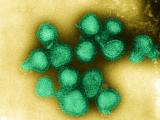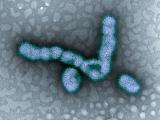Mar 9, 2010 (CIDRAP News) – European countries won't likely experience another wave of pandemic H1N1 influenza cases this spring and summer, though the virus will probably continue to circulate and be the region's dominant strain for the next flu season, the European Centre for Disease Prevention and Control (ECDC) said today.
The agency made the predictions in an 18-page risk-assessment report designed to help countries adjust their vaccine and flu-response strategies over the coming months. However, the ECDC warned that the outlook could change if there are "significant unrecognized uninfected populations" or if the pandemic virus changes to become more transmissible.
The ECDC based its predictions on advice from influenza experts, findings from the few serologic studies that have been done, events during previous pandemics, and mathematical modeling work that attempts to estimate the number of people that have already been infected or have some immunity.
Though over time all pandemics ease and the virus becomes the dominant seasonal strain, history shows the transition can happen quickly, such as in 1957, or take about two seasons, as for the 1918 and 1968 pandemics, the report notes.
It says the extent of transmission in European countries has been difficult to determine. So far, there have been few published serologic studies. One of the first large-scale serologic studies of the pandemic virus was conducted by researchers from England's Health Protection Agency, who found that one in three children were infected in hard-hit areas, 10 times higher than surveillance estimates.
The autumn-winter pandemic flu wave seemed to spread across Europe roughly from west to east and from north to south, similar to the interpandemic pattern, the report said. Though flu barometers have declined in most countries, low-level transmission and deaths continue to occur.
Looking back at Europe's experience with past pandemics, the report says the region has seen similarities between the current pandemic and the 1957 H2N2 outbreak, such as school-based transmission and the focus on younger age-groups. In the latter pandemic, however, Europe experienced a single wave with a late rise in deaths that seemed to result from cardiovascular events in older people who were sick with the flu.
During the 1968 pandemic, which involved an H3N2 strain, data increasingly suggest that in Europe the virus became more transmissible during the first and second winters. "This seems to have been due to a real change in the virus rather than to the fact that the virus circulating during the first winter was a blend of the new pandemic virus and the preceding seasonal A (H2N2) virus," the authors wrote.
The big question now is whether there will be enough susceptible people to sustain transmission, given the observed low transmissibility of the pandemic H1N1 virus, the report says. Transmission will depend on how many people have pre-existing immunity, how many have already been infected, and how many have been immunized. Though the European Medicines Agency is gathering vaccination information from member states, some countries rolled out the pandemic vaccine so quickly that immunization records may be sparse or slow to be tabulated.
However, early indications, such as the absence of a major resurgence in most of Europe through January, suggest that there aren't enough susceptible people to sustain large-scale transmission, the ECDC says. Modeling estimates for the United Kingdom suggest that the probability of another flu wave in the spring or summer is very low, but the ECDC experts emphasize that that prediction might not apply to other countries and that there may be populations in the European Union that have been relatively unaffected by pandemic virus transmission so far.
German experts have estimated that the country would need to reach an immunity threshold of 29% to 38% to prevent continued pandemic flu transmission, the report says. Modeling calculations suggest Germany has reached an immunity level of 25%, which is close to the threshold.
Given the low-level transmission and that the pandemic virus is likely to dominate the next flu season, the ECDC experts recommend that EU citizens receive the pandemic vaccine if it is offered to them. They also recommend that children, pregnant women, and those with underlying medical conditions be vaccinated, because they are still at risk for flu complications.
In the meanwhile, the group recommends that EU countries continue clinical and virologic surveillance, conduct high-quality seroprevalence studies, and review and revise their risk groups. The report also advises countries to strengthen surveillance for severe respiratory infections and deaths and determine if any patterns are seen in specific age-groups.
Countries should consider adjusting risk estimates for their own citizens and examine flu mortality patterns by age-group and risk factors, the report says. In particular, it suggests determining H1N1 mortality in different age and risk groups and comparing it with seasonal flu mortality using measures such as years of potential life lost.
See also:
Mar 9 ECDC risk assessment
Jan 21 CIDRAP News story "Serologic study finds H1N1 infections surged past official estimates"


















